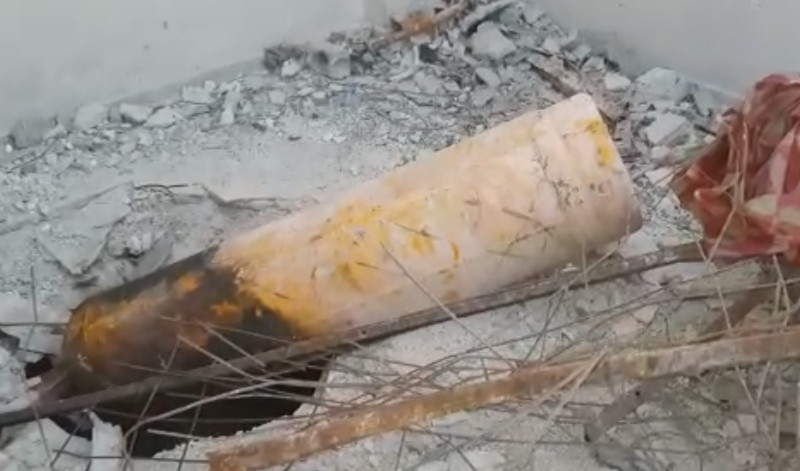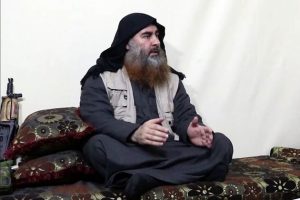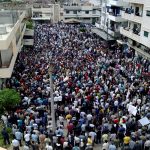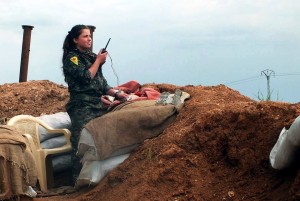by Helena Cobban
[Ed. note: This story has been updated with additional information below.]
Last month, a network of UK-based academics challenged allegations—which the Organization for the Prohibition of Chemical Weapons (OPCW) officially corroborated on March 1—that the Syrian government used chemical weapons against civilians in the outer Damascus suburb of Douma in April 2018.
The challenge came in the form of a 15-page assessment, apparently prepared by a team of OPCW engineering experts, that seriously critiqued a fundamental conclusion of the March report. An unknown party leaked this assessment to the UK-based network, the Working Group on Syria, Propaganda and Media. OPCW staff members have indirectly confirmed the authenticity of the assessment.
The main conclusions of the 15-page assessment seem very serious. But its diplomatic and political impact are no less serious. It threatens to bring the still-young OPCW to its biggest political crisis since 2002, when President George W. Bush and his allies unceremoniously ousted its first director-general, José Bustani, for reportedly wanting to deploy OPCW inspectors to Iraq, which could have complicated the lead-up to the invasion the Bush team was planning.
The leaked engineering assessment raises grave questions about the integrity of the OPCW’s supposedly apolitical, purely technical internal processes and throws significant doubt on the OPCW accusation that the Syrian government was responsible for several earlier chemical weapons incidents. Douma was, after all, the only site the OPCW’s own inspectors were able to visit and inspect. For all the other incidents, the organization had to rely on reports produced by strongly pro-rebel organizations like the so-called “White Helmets” or Al Jazeera. These reports spread speedily via various web platforms and prompted President Trump and his British and French allies to launch a barrage of 105 cruise missiles against Syrian government scientific facilities on April 14, 2018. Luckily, that act of unauthorized international aggression did not lead to any wider eruption of hostilities.
On April 9, Syrian government forces quickly retook the locations in Douma where chemical weapons were allegedly used. Syria has been a full member of the OPCW since 2013. On April 10, 2018 it asked the OPCW to “urgently” send a Fact-Finding Mission (FFM) to Douma to investigate and verify what happened there. On April 12, an advance team from the FFM arrived in an unnamed “neighboring country.” The U.S.-led bombing occurred on the morning of April 14. Later that day, some members of the FFM apparently arrived in Damascus. Over the month that followed, they were able to interview 13 witnesses and receive environmental and biomedical samples from Douma.
Because of continuing security concerns in Douma, the FFM was unable to deploy any of its team members there for a further week. But between April 21 and May 1, FFM teams were able to inspect three key facilities in Douma: a hospital that had earlier been a White Helmets outpost and two residential buildings a short distance away, which were tagged in the OPCW report as “Location 2” and “Location 4.”
Here are the uncontroversial facts about the Douma incident. While the area was still under the control of the Jaysh al-Islam rebels, some 43 people in the area died ghastly and much-photographed deaths from the effects of a chemical agent believed to have been chlorine, which also wounded an additional number of people. The first photos and videos of the non-fatal casualties were taken (according to their metadata) in the early afternoon of April 7. The first images of dead casualties—many of them in Location 2—were taken around 10:30 that evening.
By noon of April 8, electronic images showed, at Location 2, a partly damaged long yellow cylinder thought to contain some chlorine, that was shown lying on the building’s reinforced concrete roof, with one end hanging over a hole punched through the roof by an object of similar cross-section. Images from Location 4, meanwhile, showed a similar yellow cylinder, less damaged and still apparently full of chlorine, lying in a top-floor room in whose reinforced concrete ceiling an oval, similarly shaped hole had been punched. This cylinder was not under the hole but off to one side of it, incongruously positioned on a flimsy-looking double bed.
The difference of judgment between the “final” report on the incident that the OPCW issued on March 1 and the “engineering assessment” leaked last month centered on the provenance of these two cylinders. How had they gotten to where they were photographed on April 8 and where they were later inspected by the FFM?
By the time the FFM arrived in Douma, the bodies had been long buried. The FFM did not exhume them. In its report, it stated that it was “not currently possible to precisely link the cause of the signs and symptoms [displayed by the casualties] to a specific chemical.” It stated that no organophosphorous nerve agents (such as sarin) were detected in any of the bio-medical or environmental samples it took, but the deadly chemical could have been “reactive chlorine” of the kind contained in the two cylinders.
The report stated that “the structural damage to the rebar-reinforced concrete terrace at Location 2 was caused by an impacting object with a geometrically symmetric shape and sufficient kinetic energy to cause the observed damage…” Regarding the cylinder found at Location 4, it stated that, “The studies … indicated that, after passing through the ceiling and impacting the floor at lower speed, the cylinder continued an altered trajectory, until reaching the position in which it was found.”
That is, the report stated that both cylinders had been delivered to their final, much photographed resting-places by being dropped onto the roof (at Location 2) or through the roof (Location 4.) The report did not specifically assign blame, but the only party using aircraft during the Douma battle that could have dropped the cylinders were the Syrian army and perhaps their Russian allies.
The leaked engineering assessment punched a hole right through that conclusion. It is dated February 27, 2019—just two days before the FFM’s final report was released. It includes several in-depth studies, including some based on simulations, of what the concrete roofs and their rebar would have looked like if they were impacted or pierced by the cylinders, as well as the damage the cylinders should have registered as result of those impacts. It concluded:
[T]he FFM engineering sub-team cannot be certain that the cylinders at either location arrived there as a result of being dropped from an aircraft… In summary, observations at the scene of the two locations, together with subsequent analysis, suggest that there is a higher probability that both cylinders were manually placed at those two locations rather than being delivered from aircraft.
If the cylinders were put into their final positions by hand and they were photographed there while Jaysh al-Islam was still in control of the area, then suspicion would of course fall on Jaysh al-Islam—not just for putting the cylinders into position but also for staging the whole incident in a way to lay blame on the Syrian government. Jaysh al-Islam would also likely bear some responsibility for the 43 gruesome deaths recorded in the many photos and videos taken during those two days and circulated so widely at the time.
The leaked engineering assessment contains eight pages of closely argued analysis, a list of appendices, and six pages of technical drawings. The end of the analysis bears the typed sign-off “Ian Henderson,” which is the name of a senior inspector who has been with the OPCW ever since it started getting staffed up in 1997-98. Each page is headed “UNCLASSIFIED – OPCW Sensitive / Do not circulate.” The first page is headed “DRAFT FOR INTERNAL REVIEW” and bears a handwritten annotation: “Final version – for comments (by hand to TM [Team Members] only.”
The OPCW’s formal report contains a “Mission Timeline” that records that “consultations with engineering experts” lasted for much of October and November of last year and that “reception of engineering studies” occupied much of December. Thus, considerable discussion between the engineering team and the FFM’s leadership probably took place during those months.
After the engineering assessment was leaked last month, the OPCW first tried to claim that the document had no standing in the organization. Then, in an email to British journalist Peter Hitchens, it stated, “the OPCW Technical Secretariat is conducting an internal investigation about the unauthorised release of the document in question”—a formulation that seems to concede its authenticity.
Questions about this very disturbing matter have been asked in the British Parliament. Officials in some non-Western states that are OPCW members are also reportedly demanding more information. Here in the United States, no members of Congress have yet raised this issue. But the Syrian rebels and their supporters have offered recent warnings of possible new chemical attacks in beleaguered Idlib. And on May 21, a State Department spokeswoman said that the Syrian government “might be renewing its use of chemical weapons” in that region and warned that any use of such weapons would lead the United States and its allies to “respond quickly and appropriately.”
Surely, all Americans who remember how unfounded allegations about Weapons of Mass Destruction were used to catapult our military into the invasion of Iraq should be very wary of that ruse being pulled again.
I remember the hopes that so many of us had, back in the mid-1990s, when scores of countries worked together to negotiate the treaty that established the OPCW. This was the first time that most of the world’s nations came together to ban an entire class of horrendous weapons and to establish a body (the OPCW) that could aid and monitor this process. In 2002, President Bush used his power on the world scene in a quite unacceptable way to bully the OPCW. It’s important to make sure that the power of the warmongers is not used once again to subvert the OPCW’s integrity, a development that could now, as in 2002-03, pave the way for a terrible war.
Update: On June 13, OPCW Director-General Fernando Arias released the text of a briefing he had given on this matter to the States Parties to the OPCW two weeks earlier. Arias did not utter the name of Ian Henderson, the long-time OPCW staff member whose name was on the leaked version of the dissident engineering report. But he confirmed that report’s author was an OPCW staff member who was “a liaison officer at our Command Post Office in Damascus,” and “As such… he was tasked with temporarily assisting the FFM with information collection at some sites in Douma.”
Arias said that because the staff member’s report had “pointed at possible attribution” of the Douma attack, it fell outside the purview of the Fact-Finding Mission and therefore received no mention in the FFM’s report. However, he said, that on his advice the staff member had submitted it to the separate Investigation and Identification Team working on the Douma incident, which has yet to start work. He stated that three external experts (also un-named) had conducted the analyses of the ballistics/physics of the cylinders’ provenance whose conclusions were included in the FFM’s March 1 report.
The conclusions of the dissident engineering report have meanwhile been endorsed by Prof. Theodore Postol, a distinguished professor emeritus of Science, Technology, and International Security at MIT who has advised numerous U.S. presidents on strategic and scientific matters.






Thanks to Helena Cobban for this good investigative reporting. It raises serious questions about OPCW Note S/1731/2019 issued by the OPCW Technical Secretariat on March 1, 2019. Whether the OPCW Executive Council is taking up this matter, or whether there is consideration of convening a meeting of the OPCW Conference of States Parties on this matter, are not addressed. Looking from the outside, it would seem that one or both should be happening.
They didn’t wait for the result of inspection because the “quick” response of the “civilized” nation’s like US and France should be delivered as “hot” as possible on top of an emotional tide before the atmosphere of wisdom makes it cool!
This is how advanced Demo-Cracies work!
Helena,
1 First, let us remember that we are carrying out this debate about responsibility and cause of less than a hundred deaths in Douma last April, that the civilians of Idlib are being massacred from the air this June, and there is no debate about who is responsible for these war crimes because it is Russian & Syrian planes carrying out the aerial bombardment.
2 It claims to be an Executive Summary, but it includes no links, footnotes, or references to the document being summarized, and we have no assess to it, just this summation. We also have no access to this math calculations or data.
3 The only name credited for this 15-page engineering assessment is Ian Henderson. He has not been heard from or vouched for this report since if was made public. It is therefore completely unverified.
4 OPCW has said Ian Henderson has never been a member of the FFM, and the engineering sub-team was not part of the FFM investigation
5 The 15-page engineering assessment makes a great many assumptions, and in doing so it violates basic OPCW-FFM methodology of making analyses based on the facts and data collected and corroborated by the team and not on assumptions.
6 It speculates about the uses of helicopters and the heights that might have been involved. This is information that goes beyond the FFM’s mandate and methodology.
7 It was dated 2 days before the OPCW report came out. Its unknown when the OPCW might have received it, if they received it, but in any case, this 15-page assessment was introduced too late to affect the OPCW report.
8 It was marked unclassified by its producer, but carries a OPCW like confidentiality classification that isn’t a real OPCW confidentiality classification. It is marked “Do not circulate,”
9 This 15-page engineering assessment was never classified, so it was not leaked. Those claiming it was leaked are trying to hype it.
10. The questions it raises are not new. These objections had already been raised by Russian and Syria, and answered by the OPCW in its 19-page response to them.
It is being widely promoted by supporters of the Bashar al-Assad, whose forces have been alleged to have use CW hundreds of times in Syria, to attack the credibility, and undermine the authority of the OPCW.
Clay Claiborne
What are your recommendations on how to deal with the Jihadists and their civilian supporters?
Assad did NOT use chemical weapons since the beginning of the Syrian war, USA and her followers faked the evidences to blame the winning Syrian army.